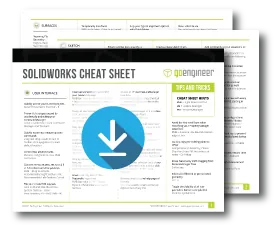How to Reorder SOLIDWORKS Sheet Metal Bends
In SOLIDWORKS, the default bend order follows the order in which bend features were created. This article explains what the default order is, how to display it in drawings, and how to change it. Let's start with a simple sheet metal part as an example.

Figure 1: The example part in a formed state
This part has three features. In order, they are:
A Base Flange:

Figure 2: Base-Flange1
Followed by two Edge Flanges:

Figure 3: Edge-Flange1

Figure 4: Edge-Flange2
In the screenshots above, you can see that, collapsed beneath every sheet metal feature, are bend sub-features. For example, Edge-Flange2 contains EdgeBend3 and EdgeBend4.
When the example part is flattened and its flat pattern feature is expanded, you can see a list of flatten features that follows the order in which the bend features appear in the FeatureManager Design Tree.

Figure 5: Example part flattened with Flat Pattern feature expanded
The practicalities of manufacturing may mean the best way to model the part does not match how the part will be made on the shop floor. With the Reorder tool, you can update the bend order in the model to reflect the real-world fabrication process.
How to Change Bend Order
For example, in a drawing of this example model, we want the bend order to reflect that, when manufacturing this sheet metal part, each tab will be folded up 90° first, then down 90°. The original, default bend order does not match that because it follows the order in which features were created.

Figure 6: Flat Pattern Drawing View with Bend Notes showing the original Bend Order
To change the order, activate the flat pattern derived configuration, then right-click on the flat pattern feature and select Reorder Bends.

Figure 7: Reorder Bends option in the Flat Pattern right-click menu
This will open the Reorder Bends dialog. It shows a list of all the bend sub-features in reverse order creation order. That is, the bend that is first in the Feature Tree and marked as bend “1” in the drawing will be last in Reorder Bends. To change the order, select a bend and click on the Move Up or Move Down buttons. Left-clicking the bends also highlights them in the Graphics Area.

Figure 8: Reorder Bends dialog
After moving bends around, the Bend Order as seen in Bend Notes on a flat pattern drawing view is:

Figure 9: Bend Order after Reordering Bends

Figure 10: Associated Reorder Bends dialog
Bend Order in Drawings
When inserting a flat pattern drawing view into a drawing, there will be checkboxes in the PropertyManager for Bend Lines and Bend Notes. Checking them imports bend lines and notes with information about the bends into the drawing. The default information included in the bend notes is controlled by the bend line note file (bendnoteformat.txt, located in the folder specified in System Options > File Locations > Sheet Metal Bend Line Note File). What appears in the bend notes can be edited by adding or removing text and tags that link to details about the bend, like the direction, angle, and order.
To include the Bend Order, click the Bend Order button or manually type <bend-order> in the note text box.

Figure 11: Bend Notes section of a Flat Pattern Drawing View PropertyManager
Alternatively, you can use a Bend Table to display information about your bends, including the order. After inserting a Bend Table, any bend notes imported with the drawing view are replaced by a simple tag referencing a row in the Bend Table.
Comparing Figure 12 to Figure 9, you’ll notice that the Bend Order displayed by the bend notes is different from the way the Bend Table is ordered—in fact, it’s reversed. That’s because the Bend Table follows how bends are listed in the Reorder Bends dialog. When changing the Bend Order using Reorder Bends, it’s therefore important to consider how you want to convey the Bend Order in a drawing of your part.

Figure 12: Flat Pattern Drawing View with Bend Table
I hope you found this article explaining how to reorder sheet metal bends in SOLIDWORKS helpful. Check out more SOLIDWORKS tutorials below. Additionally, join the GoEngineer Community to create forum posts, enter design contests, and answer questions from other SOLIDWORKS users.

SOLIDWORKS CAD Cheat Sheet
SHORTCUTS ⋅ MOUSE GESTURES ⋅ HOT KEYS
Our SOLIDWORKS CAD Cheat Sheet, featuring over 90 tips and tricks, will help speed up your process.
Related Articles
SOLIDWORKS STEP Export: AP203 vs AP214
Automatic Unit Conversion in SOLIDWORKS File Properties
Exploded Views for SOLIDWORKS Multibody Parts
Faster DWG Conversions Using the SOLIDWORKS 2D to 3D Toolbar

About Lauren McGarry
Lauren McGarry is a Certified SOLIDWORKS Expert based out of San Diego, California. She earned her Bachelor of Science degree from Case Western Reserve University and has been with GoEngineer as a Technical Support Engineer since 2016.
Get our wide array of technical resources delivered right to your inbox.
Unsubscribe at any time.